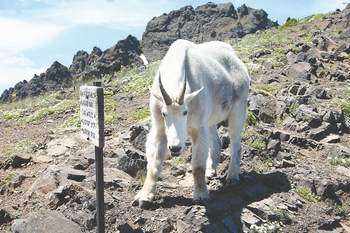Anyone who has been out hiking, searching for Sasquatch, tracking mystery cats, and otherwise going into the backcountry must be aware of how dangerous known animals can be. There have been several cases, in recent weeks, of animal attacks. None may be more shocking to folks than to hear a mountain goat has killed a man over the weekend.
Park wildlife biologist Patti Happe this week will assist in a necropsy of a goat that killed a hiker as part of the investigation into what happened Saturday.
The necropsy will include a physical evaluation of the goat as well as testing for a variety of diseases by a certified veterinary pathologist in Monroe, said park spokeswoman Barb Maynes on Sunday.
Along with an evaluation of a goat, which was shot and killed by park rangers after it killed hiker Robert Boardman by goring him through the thigh, park officials will interview people who were with Boardman shortly before the attack and any other witnesses who were in the area.
Maynes said she did not know if Boardman was injured through the front or back of his thigh.
“No one saw the injury happen. I don’t know that we have enough right now to say,” she said.
“We know that there was some kind of encounter, but we don’t know exactly what transpired.
“We are trying to really learn everything that we can.
‘It is a tragedy’
“It is a tragedy that we are taking extremely seriously, and we are trying to learn as much as we possibly can, and as we do, we will be releasing that information and sharing it with the public.”
Boardman, 63, was hiking with his wife, Susan Chadd, and their friend, Pat Willits, on the Switchback Trail to Klahhane Ridge about 17 miles south of Port Angeles.
The three had stopped for lunch at an overlook when a goat began moving toward them at about 1:20 p.m.
When the goat began acting aggressively to the trio, Boardman urged Chadd and Willits to go on while he attempted to get rid of the goat and then leave himself, Willits told an off-duty park ranger who arrived on the scene shortly after.
Dr. Margaret Bangs, a local private-practice doctor, said the two women fleeing the area warned her not to go up because of problems with the goat.
“I was in the saddle just before you get to the other hill on the Switchback Trail,” Bangs said.
Goat following hiker
‘”I looked up, and you could see him [Boardman] with two walking sticks and that goat following, just breathing down his neck.”
She tried to make a cell phone call but did not have service.
“I was too much behind the mountain to get service, so I left to do the only thing I could think of to help: I went to go find a ranger,” Bangs said.
By the time she got to an area with a ranger, someone with a cell phone had already phoned in.
Mike Dawson of Port Townsend was on a day hike in the area when he came upon attempted rescue efforts about an hour after Boardman was injured.
“The rescue workers were trying to get in there, but the goat wouldn’t leave,” he said.
“Eventually, they got a group of people together to scare him away, but he was still guarding the area an hour later.”
He watched as a Coast Guard helicopter hoisted Boardman and attempted to resuscitate him.
Boardman was pronounced dead at Olympic Medical Center that afternoon.
In 2008, park officials warned of an aggressive goat in the Klahhane-Hurricane Ridge-Switchback Trail area.
Both park visitors and staff had reported a billy goat on the trail that had approached hikers, followed them and refused to back down, Maynes had said then.
On Sunday, she said it was unknown if only one goat or several were the subject of the reports.
And she didn’t know if the billy goat that killed Boardman was the same goat that had intimidated other hikers for at least two years.
“We have had specific reports that we can specifically link to one individual goat,” Maynes said.
“We also have reports of goats not moving off the trail or following people that are impossible to link to a particular goat.”
Various facts are shared about the recent history of goats in Olympic National Park, and then the article continues with more details about nearby other aggressive animals:
Tip of the hat to InvisibleInk.

